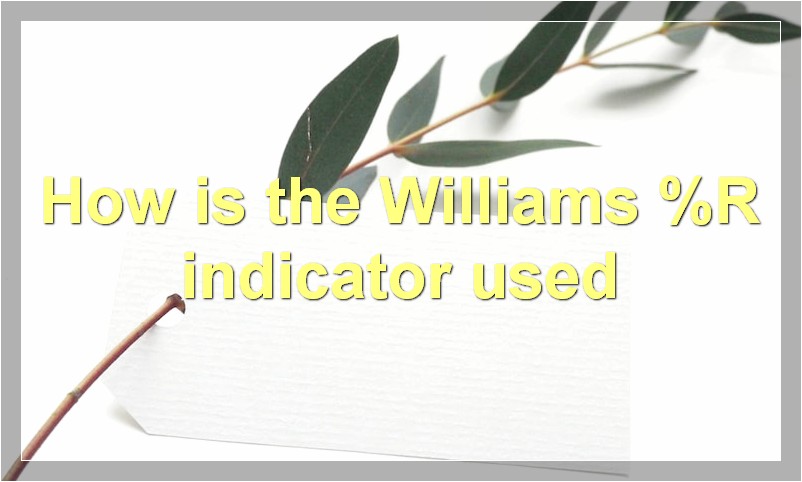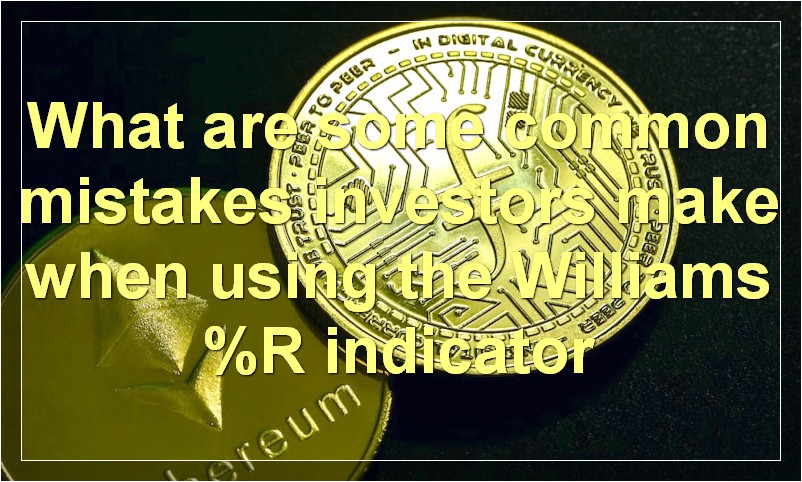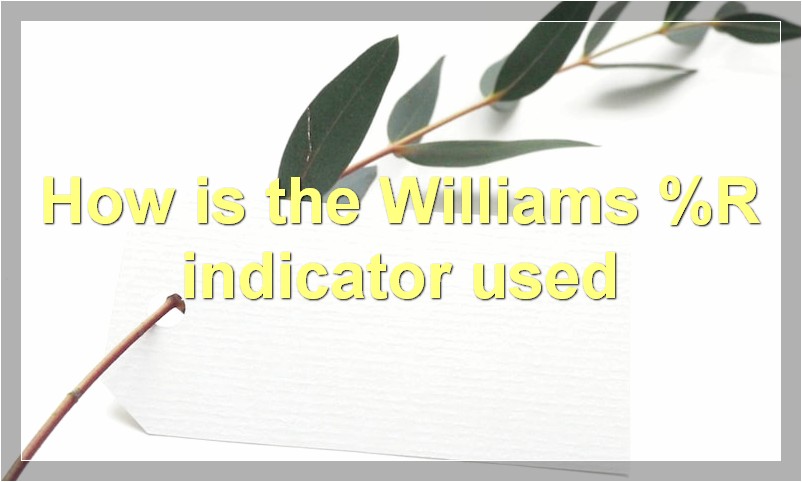If you’re a day trader, then you know the importance of technical indicators. And if you’re looking for a new indicator to add to your arsenal, then you need to check out the Williams %R indicator.
What is the Williams %R indicator
The Williams %R indicator is a momentum oscillator that measures overbought and oversold levels. The indicator ranges from 0 to -100, with readings below -80 considered oversold and readings above -20 considered overbought. The Williams %R indicator is similar to the Stochastic Oscillator, but is more responsive to price changes.
How is the Williams %R indicator used

The Williams %R indicator is a momentum oscillator that measures overbought and oversold levels in the market. The Williams %R is calculated using the following formula:
%R = (Highest High – Close)/(Highest High – Lowest Low) * 100
The Williams %R indicator is used to find market turning points by identifying overbought and oversold conditions. The indicator can be used on any time frame, but is most commonly used on daily or weekly charts.
The Williams %R indicator is considered overbought when it is above 80 and oversold when it is below 20. These are the levels at which the market is considered to be overextended and ripe for a reversal. However, it is important to note that the Williams %R indicator is a lagging indicator, so it will not signal a market reversal until after the fact.
What is the formula for the Williams %R indicator
The Williams %R indicator is a momentum oscillator that measures overbought and oversold conditions in the market. The indicator scales from 0 to -100, with readings below -80 indicating overbought conditions and readings above -20 indicating oversold conditions. The Williams %R indicator can be used to identify trend reversals and generate buy and sell signals.
What are the pros and cons of using the Williams %R indicator
The Williams %R is a momentum indicator that measures overbought and oversold levels in the market. A reading of 0 to -20 is considered overbought, while a reading of -80 to -100 is considered oversold. The Williams %R can be used to find entry and exit points in the market.
Pros:
-The Williams %R is a simple indicator that is easy to understand and use.
-It can be used to find both overbought and oversold levels in the market.
-This indicator can help you time your entries and exits in the market.
Cons:
-The Williams %R can give false signals in a choppy market.
-This indicator should not be used alone, but rather in conjunction with other technical indicators.
How can the Williams %R indicator be improved
The Williams %R is a momentum indicator that was created by Larry Williams. It is used to measure overbought and oversold conditions in the market. The Williams %R is calculated using the following formula:
%R = (Highest High – Close)/(Highest High – Lowest Low) * 100
The Williams %R can be improved by using a longer time period when calculating the indicator. A longer time period will help to smooth out the indicator and make it more accurate.
What are some common mistakes investors make when using the Williams %R indicator

When it comes to technical analysis, there are a lot of different indicators that investors can use to try and predict where the market is headed. One of those indicators is the Williams %R, which is a momentum oscillator that measures overbought and oversold levels.
However, just like with any other indicator, there are potential mistakes that investors can make when using the Williams %R. Here are some of the most common mistakes:
1. Not Taking into Account the Time Frame
One mistake that investors can make is not taking into account the time frame that they’re looking at. The Williams %R is a short-term indicator, so it’s not going to be as accurate for longer-term predictions. Investors need to be aware of this and use other indicators in conjunction with the Williams %R to get a better idea of where the market is headed.
2. Overlooking Other Factors
Another mistake that investors can make is overlooking other factors that can affect the Williams %R readings. For example, if there’s a big news event that happens, it could cause the indicator to give false readings. So, investors need to be aware of all the different factors that could affect the indicator before making any decisions based on its readings.
3. Not Using It in Conjunction with Other Indicators
As we mentioned before, the Williams %R is best used in conjunction with other indicators. By itself, it’s not going to give investors the whole picture. But when used together with other indicators, it can provide valuable insights into where the market is headed.
4. Making Decisions Based on Extreme Readings
Finally, one last mistake that investors can make is making decisions based on extreme readings from the Williams %R. Just because the indicator says that the market is overbought or oversold doesn’t mean that it’s necessarily true. Investors need to look at all of the other factors involved before making any decisions.
These are just some of the common mistakes that investors can make when using the Williams %R indicator. By being aware of these mistakes, investors can hopefully avoid them and make better decisions when using this indicator.
What are some alternate ways to interpret the Williams %R indicator
There are a few ways to interpret the Williams %R indicator. One way is to use it as a tool to identify overbought and oversold conditions in the market. This can be done by looking for readings above -20 or below -80 on the Williams %R scale. Another way to interpret the Williams %R indicator is to use it as a trend following tool. This can be done by looking for readings above -50 on the Williams %R scale, which would indicate an uptrend, or readings below -50 on the Williams %R scale, which would indicate a downtrend.
Does the Williams %R indicator work in all markets
The Williams %R indicator is a momentum oscillator that is used to measure overbought and oversold levels. The indicator ranges from 0 to -100, with readings above -80 considered overbought and readings below -20 considered oversold. The Williams %R indicator can be used in all markets, but it is most popular in the forex market. The Williams %R indicator is a useful tool for finding trade entry and exit points.
How does the Williams %R indicator compare to other technical indicators
The Williams %R indicator is a momentum oscillator that measures overbought and oversold levels in the market. Unlike other technical indicators, Williams %R does not produce false signals as often, making it a more reliable tool for traders.
What are the limitations of the Williams %R indicator
The Williams %R indicator is a technical analysis tool that is used to measure overbought and oversold conditions in the market. The indicator ranges from 0 to -100, with readings above -20 considered overbought and readings below -80 considered oversold. However, the Williams %R indicator has some limitations that traders should be aware of.
One limitation of the Williams %R indicator is that it is a lagging indicator. This means that it will only provide signals after the fact, rather than in real-time. This can make it difficult for traders to act on the signals in a timely manner. Additionally, the indicator can give false signals in choppy markets.
Another limitation of the Williams %R indicator is that it is based on closing prices. This means that it does not take into account intraday price action. As a result, the indicator may not provide accurate signals for day traders.
Despite these limitations, the Williams %R indicator can still be a useful tool for traders. When used in conjunction with other technical indicators, it can help to give a more complete picture of market conditions.

